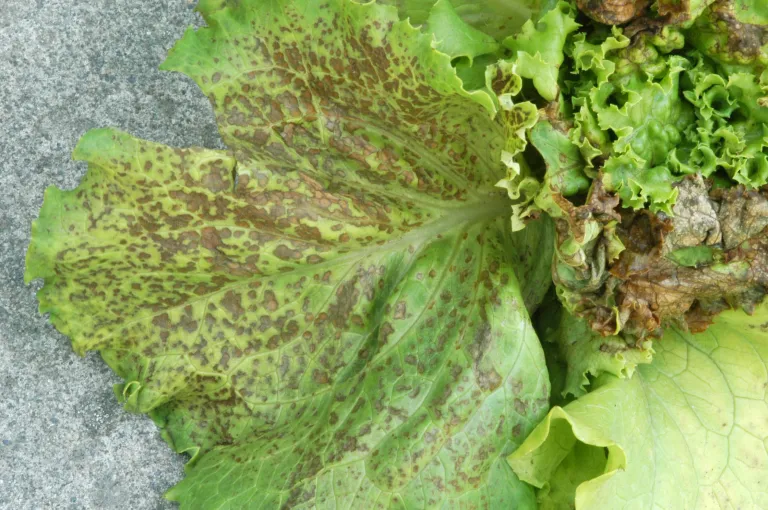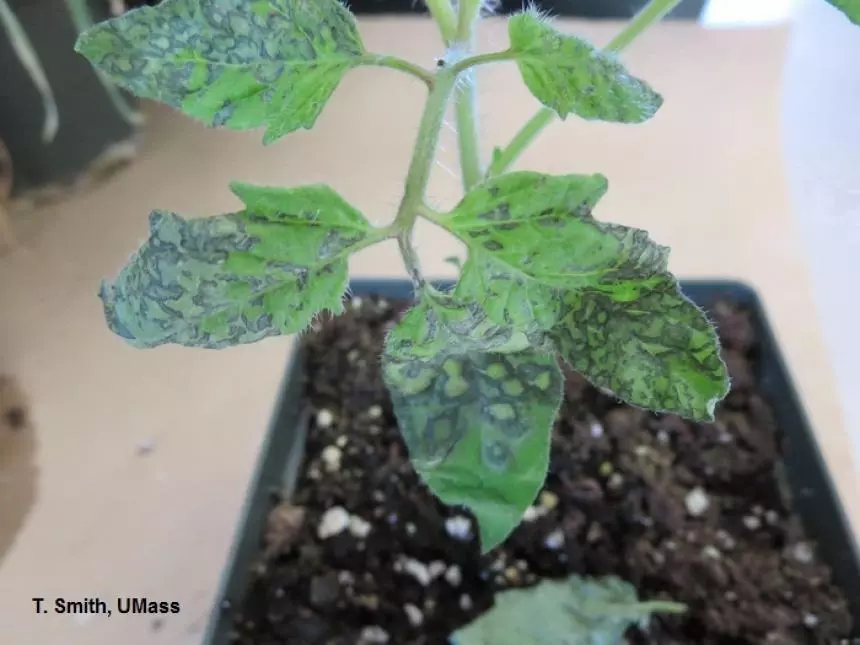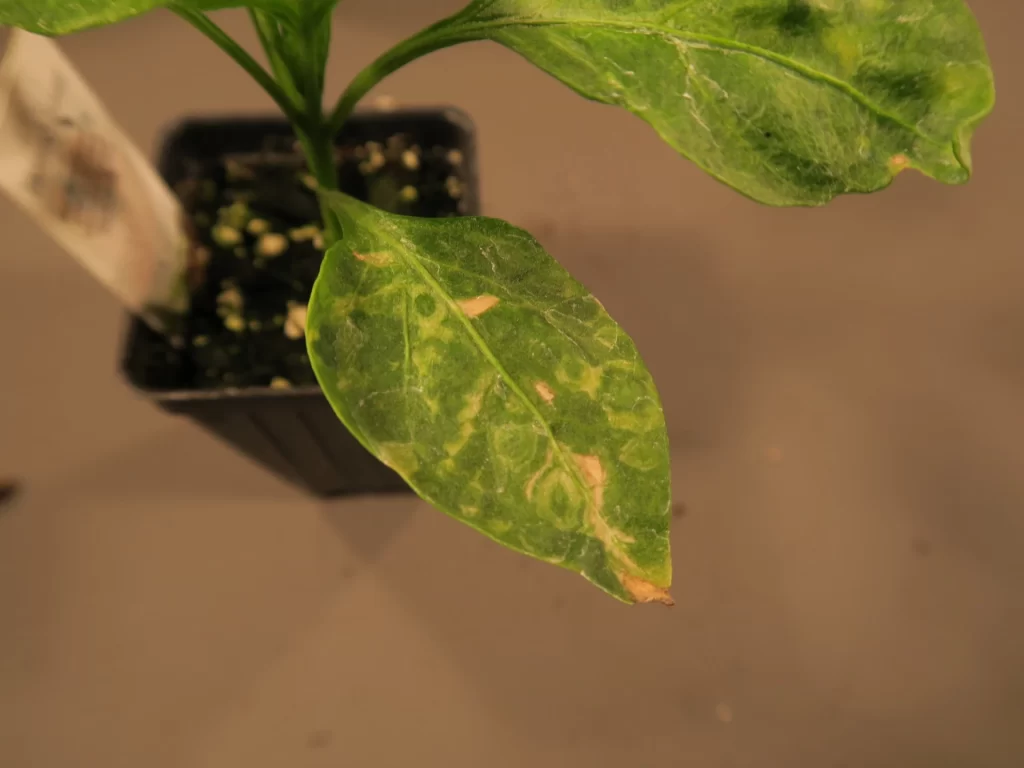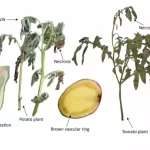Impatiens Necrotic Spot Virus
An emerging threat to greenhouse vegetables
Impatiens necrotic spot virus first emerged in floriculture and nursery crops [1] and is now affecting and causing considerable losses to these greenhouse-grown vegetable crops such as cucumber, tomato, pepper, and lettuce [2]. An economic analysis done on two lettuce growers in the Salinas Valley of Monterey County, California has shown that the virus has already caused a loss of $400,000 [3]. A stakeholder survey also showed that there were 750 crops affected by this virus in Monterey County alone [3]. This virus results in total loss of the plant as it becomes no longer marketable. Growers are also unable to save the seeds as they can continue to spread the virus [4].

The virus spreads like wildfire and some growers may be unaware of the increasing risk that this virus poses. In this pathogen profile, we will be looking at how the virus spreads, its symptoms of the virus and ways to control it.
We provide great overviews of many agricultural microorganisms. Subscribe to stay updated!
Symptoms
Symptoms vary based on factors such as the plant it infects and environmental conditions. Infected plants may exhibit any of the following symptoms:
- Chlorotic or necrotic spotting
- Stem, vein or growing point necrosis
- Ringspot, mosaic or line patterns on leaves
- Colour breaks in flowers
- Wilting and collapse
The age of the plant also affects the severity of symptoms. Plants infected at a young age usually exhibit more severe symptoms than plants infected at an older age. Some plants also do not show symptoms but can still be a source of the virus, leading to the infection of other plants in the greenhouse [2]. The symptoms of the virus are very similar to those of another tospovirus, Tomato spotted wilt virus (TSWV). The two viruses can be hard to differentiate based on symptoms alone. It is highly recommended to send plant samples to a laboratory to confirm the presence of the correct virus [5] .

How it spreads
The virus can be spread by western flower thrips. Once a thrip is infected with the virus, it becomes a vector and can infect plants. Once a plant is infected in the greenhouse, it can spread through sap transmission. This can involve the sap of infected plants getting stuck to clothing and tools and spreading to other parts of the greenhouse [6].
Early detection of Impatiens Necrotic Spot Virus
One method to detect the virus is to use indicator plants. A good indicator plant will attract thrips and produce symptoms within a few days of the infected thrips feeding on the plant. Since symptoms will show up quickly on the leaves of the indicator plants it means it will not be systemic and the indicator plant will not serve as a reservoir for the virus. Some examples of good indicator plants include a number of petunia cultivars such as ‘Calypso,’ ‘Summer Madness,’ and ‘Super Blue Magic’ [7].
The way to use indicator plants is to place them in the greenhouse before the vegetable crop you are growing arrives. It would be best to continue growing the indicator plants alongside your crop so thrips have an attractive food source [7].

How to control the spread
To control the spread of the virus, scouters should regularly inspect any plants entering a greenhouse (e.g., new plant shipments, plants moved in from outdoors) for viral symptoms and thrips. Growers should also isolate new plants from the rest of the crop until it is determined that new plants are free of thrips and the virus. To confirm the absence of the virus in new plants, growers should get plant materials tested in a laboratory. Growers should also destroy any symptomatic plants. Monitoring and controlling for thrip populations can also help in controlling the spread of the virus [2].
References
[1] –cdfa. (n.d.). California Pest Rating Proposal for Impatiens necrotic spot virus.
[2] Impatiens Necrotic Spot (INSV) | Plant Disease Diagnostics Clinic. (n.d.). Retrieved October 31, 2022, from https://pddc.wisc.edu/2015/07/24/impatiens-necrotic-spot-insv/
[3] Hasegawa, D. K., & Del Pozo-Valdivia, A. I. (2022). Epidemiology and economic impact of impatiens necrotic spot virus: a resurging pathogen affecting lettuce in the Salinas Valley of California. Plant disease, 10.1094/PDIS-05-22-1248-RE. Advance online publication. https://doi.org/10.1094/PDIS-05-22-1248-RE
[4] What Is INSV: Learn About Impatiens Necrotic Spot Virus Symptoms And Treatment. (n.d.). Retrieved October 31, 2022, from https://www.gardeningknowhow.com/plant-problems/disease/impatiens-necrotic-spot-virus.htm
[5] UC IPM: UC Management Guidelines for Impatiens Necrotic Spot on Peppers. (n.d.). Retrieved October 31, 2022, from http://ipm.ucanr.edu/PMG/r604101021.html
[6] Impatiens Necrotic Spotted Wilt Virus (INSV) – Plant & Pest Diagnostics. (n.d.). Retrieved October 31, 2022, from https://www.canr.msu.edu/resources/impatiens-necrotic-spotted-wilt-virus-insv
[7] Impatiens Necrotic Spot: New Name, Same Threat | Pacific Northwest Pest Management Handbooks. (n.d.). Retrieved October 31, 2022, from https://pnwhandbooks.org/plantdisease/pathogen-articles/common/plant-viruses/impatiens-necrotic-spot-new-name-same-threat
Disclaimer:
The information we present in Pathogen Profile is based on collating published peer-reviewed scientific literature and sources we think are reliable. This is by no means an exhaustive review of pathogens. Pathogen Profile gives a small glimpse of what is known about pathogens, and we encourage growers to do more research on their own based on the pathogens in relation to their own crops and hydroponic systems. We are not plant pathologists thus the information presented in Pathogen Profile should not be used as professional advice to treat pathogens or operate your hydroponic system.
![]()
Tanya Irani is a Bioinformatician and Agriscience Advisor at Healthy Hydroponics




